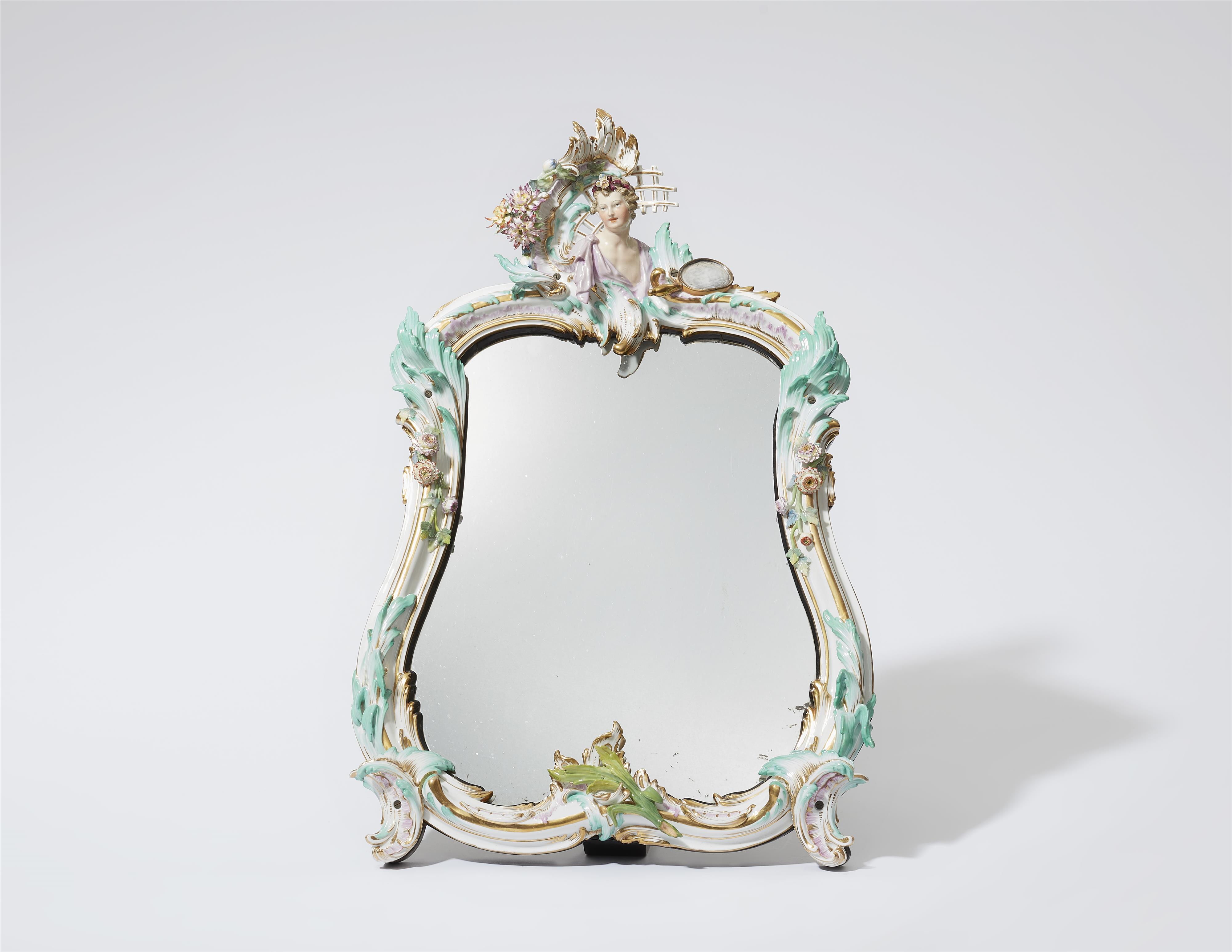A Berlin KPM porcelain table mirror from a Frederician toilette garniture
Model no. 161. Fired in several parts and screw-mounted to the ebonised wooden base, with hinged stand on the reverse. With a smooth breakage to the left side, restorations to some of the leaves, the tip of the rocaille trellis and the flowers in the lady's hair. H 59.5, W 38.5 cm.
Around 1768.
Three other versions of this rare table mirror are known to date: 1. the example published by Lenz in 1913, "painted gold, pink and green", formerly owned by Margarete Oppenheim (1857 - 1935). 2. the example published by Köllmann, then in the Karl-Heinz Wadsack collection, painted green, yellow and enamelled blue. 3. the unpainted example that appeared in the Orangerie auction in 2017.
In the archival tables with extracts from Frederick II's treasury accounts, Lenz discovered several mirrors delivered to the king. The first were presented in 1767, proudly recorded with the comment "Two mirror frames, one 14 1/2 feet high, 3 feet wide, and the other 12 1/4 feet high, 3 feet wide, made and delivered to the king's utmost satisfaction to the new palace at Sans Souci."
A delivery dated 18.6.1768 records "2 toilette sets fully painted in colours with naturalistic flowers and gold mosaic pp.". On 21st December 1768, the manufactory delivered "3 compl. toilette sets all white, each consisting of 2 candlesticks, 1 mirror, 1 large, 2 medium square toilette boxes, 2 powder tins, 2 large, 2 medium, 2 small tins for pomade pp., 2 spirit bottles, 2 pin dishes, 2 small, 2 large brushes, 1 wash basin together with 1 jug and 1 soap ball tin". A few years later, with delivery date of 25th July 1774, there is also "1 complete toilette set of 39 pieces plus mirror with colourful naturalistic flowers and gold borders".
The popularity of these sets as prestigious gifts gives us an idea of how important the daily ritual of grooming and makeup was at court. Wigs and powder created a uniformly groomed appearance that concealed revealing physical flaws and overly individualised features. Every member of the royal court underwent this "grande toilette", which also included elaborate dressing, a procedure that took up a large portion of the day.
Lavishly crafted toilette sets in silver came into fashion in France under King Louis XIV. From the end of the 17th century onwards, the goldsmiths of Augsburg produced large toilette boxes filled with numerous accessories, which were distributed throughout Europe as commissions or gifts. The first items of this type to be made of porcelain or with porcelain handles were produced by the Meissen manufactory in the early 1730s. After the Seven Years' War and the takeover of the Berlin porcelain manufactory by Frederick II, toilette items were also produced there to meet the needs of the court.
Literature
Cf. Lenz, Berliner Porzellan. Die Manufaktur Friedrichs des Grossen 1763 - 1786, vol. 1, Berlin 1913, ill. 588.
Cf. Preußische Akademie der Künste zu Berlin (ed.), Meisterwerke aus den preussischen Schlössern, Berlin 1930, Nr. 115.
Cf. Köllmann/Jarchow, Berliner Porzellan, illustration volume, Munich 1987, no. 605, sold by Christie's London, 1 May 2002, lot 45.
Cf. auction Orangerie Berlin on 30 November 2017, lot 336, for an unpainted white example.

